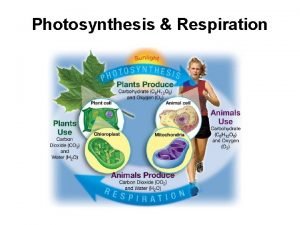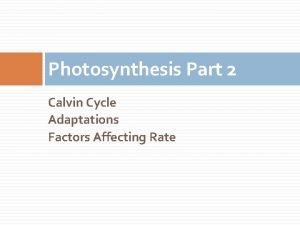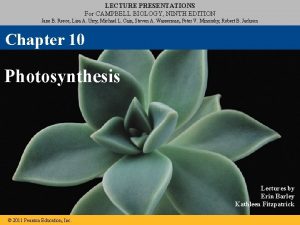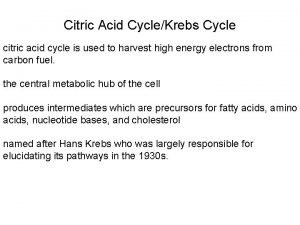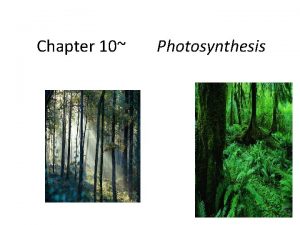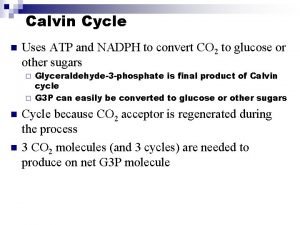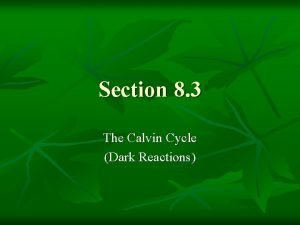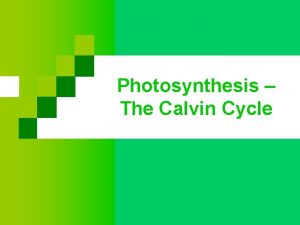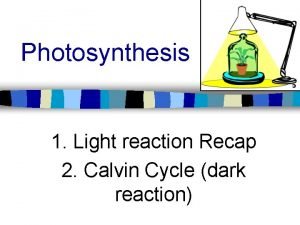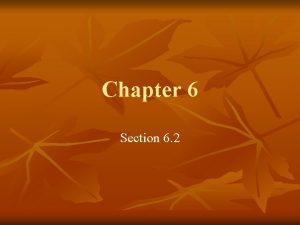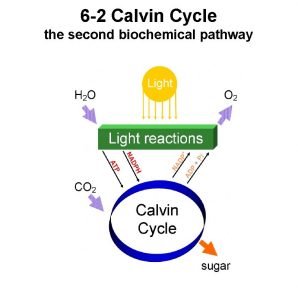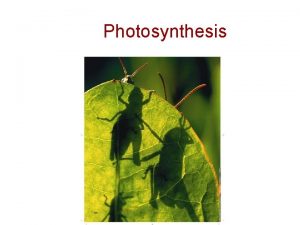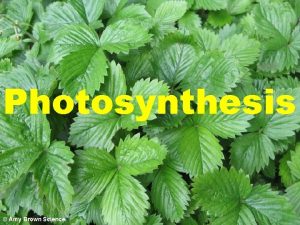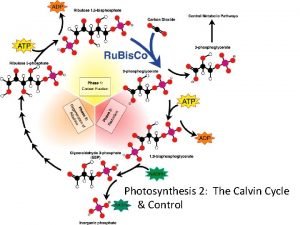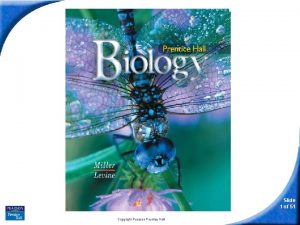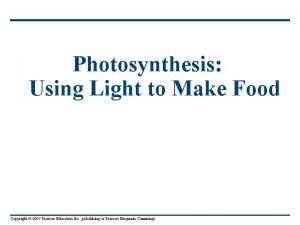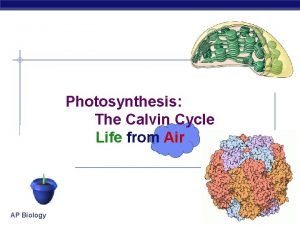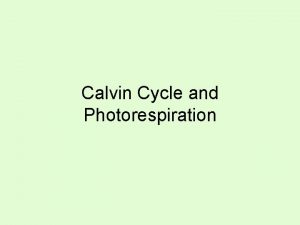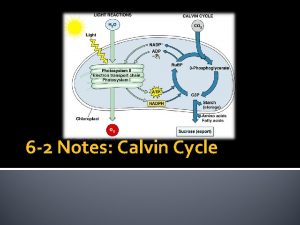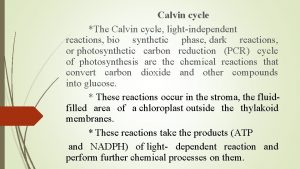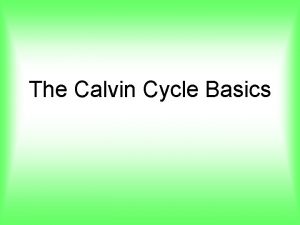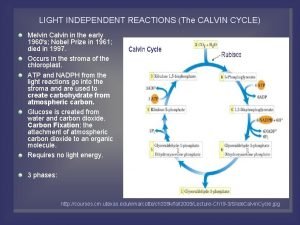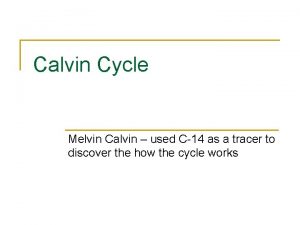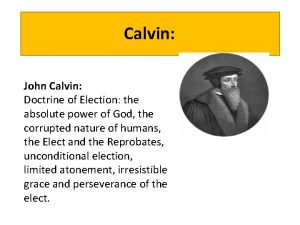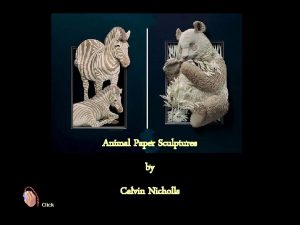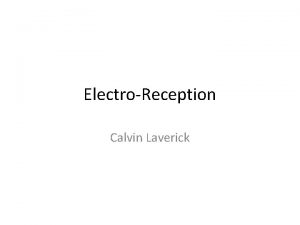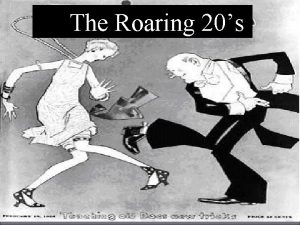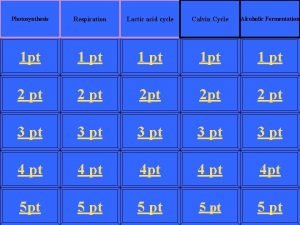UNIT 3 DAY 6 CALVIN CYCLE OPENER Sit




















- Slides: 20

UNIT 3 DAY 6 CALVIN CYCLE

OPENER Sit with your light reaction group • What do plants gain most of their biomass from? • What happens in the Calvin Cycle? • Is it spontaneous or non spontaneous? How do you know?

Photosynthesis Equation 1. What two inputs/outputs have we learned about so far? 2. What is their role in the light reactions?

AGENDA • Photosynthesis Part Two: The Calvin Cycle • Turn into box: Winter Break Homework • Homework: Photosynthesis Packet

CALVIN CYCLE So the light reaction occurs in the • Thylakoid Membrane The outputs then go to the • Stroma of the chloroplast The dark reaction (independent reaction) occurs in the • Stroma of the chloroplast The output of the dark reaction is • Sugar (carbon based!)

The Calvin Cycle is a series of chemical reactions.

The Calvin Cycle Three Stages 1. Carbon Fixation 2. Reduction 3. Regeneration


The Calvin Cycle CARBON FIXATION O C O Enzyme=Ribisco Carbon Dioxide 2 PGA C C C Ru. BP (Ribuslose bisphosphate)

The Calvin Cycle REDUCTION C C C PGA ATP NADPH C C C G 3 P

The Calvin Cycle REGENERATION C C C C 12 G 3 P C Atoms C 36 C Carbon 30 from Ru. BP C 6 from. CCO 2 C G 3 P C C 2 G 3 P C 10 G 3 P C C C Used to make Ru. BP C C Used to make glucose C C C C

THE CALVIN CYCLE: 3 PARTS 1. Fixation: • Rubisco combines Ru. Bp with CO 2, forming a six carbon molecule that immediately breaks down into a three carbon PGA 2. Reduction: • PGA reduced by ATP, NADPH, producing HIGHER ENERGY GP 3 (BUT, only one out of every six GP 3 s goes into further anabolic pathways, becoming glucose, etc. ) 3. Regeneration: • 5 carbon Ru. Bp regenerated; requires GP 3 and ATP

THE CALVIN CYCLE, FREE ENERGY AND ENTROPY The light reactions capture free energy from the sun • Stored in ATP and NADPH The stored free energy is used to “walk uphill” in Calvin Cycle: • HIGHER ENERGY, MORE ORDERED sugars are made out of LOWER ENERGY, LESS ORDERED carbon dioxide Two consequences: • Energy (from sun) is stored in sugars • Carbon—the building block of ALL BIOMOLECULES—is made available to living things

TAKE THAT SECOND LAW OF THERMODYNAMICS!!! THE CALVIN CYCLE IS ONE OF LIFE’S VICTORY DANCES IN THE BATTLE AGAINST DEATH, DECAY, CHAOS AND DISORDER

Summarize the Dark Reaction on the same paper you wrote the Light Reaction. • Highlight in • Pink the inputs • Orange the outputs THE CALVIN CYCLE

Light Reactions Calvin Cycle

PHOTORESPIRATION Stomata: pores on leaf • Closed on hot, dry days • • • Limits CO 2 access, reducing photosynthetic yield Less CO 2 more O 2 accumulation Photorespiration instead of photosynthesis Photorespiration: wasteful process that uses ATP and O 2, producing more CO 2 and no sugars

REDUCING PHOTORESPIRATION Separate carbon fixation from Calvin Cycle • C 4 Plants (sugar cane, corn, millet) • Physically separate carbon fixation from Calvin Cycle • Different cells to fix carbon vs. where Carbon Cycle occurs • Store Carbon in 4 C compounds • Different enzyme to capture CO 2 (PEP carboxylase) • Different leaf structure • CAM Plants (cactus, pineapple, vanilla, agaves) • Separate carbon fixation form Calvin Cycle by the time of day • Fix carbon during night • Store Carbon in 4 C compounds • Perform Calvin Cycle during the day


RUBISCO ARTICLE What hypothesis did the scientists have? What was their result? Read with your group • rotate who reads what section. Tell the reader to stop when there is something important to highlight
 Day 1 day 2 day 3 day 4
Day 1 day 2 day 3 day 4 Greensboro sit ins significance
Greensboro sit ins significance Day 1 day 2 day 817
Day 1 day 2 day 817 Inputs and outputs of calvin cycle
Inputs and outputs of calvin cycle Reactants of photosynthesis
Reactants of photosynthesis Calvin cycle
Calvin cycle Calvin cycle campbell
Calvin cycle campbell Inputs citric acid cycle
Inputs citric acid cycle Light reactions vs calvin cycle
Light reactions vs calvin cycle Calvin cycle
Calvin cycle What is the calvin cycle
What is the calvin cycle Calvin cycle
Calvin cycle Calvin cycle
Calvin cycle Section 6-2 the calvin cycle
Section 6-2 the calvin cycle The calvin cycle section 6-2 review
The calvin cycle section 6-2 review Whats another name for the calvin cycle
Whats another name for the calvin cycle The calvin cycle occurs in the___________.
The calvin cycle occurs in the___________. Calvin cycle
Calvin cycle What happens in the calvin cycle
What happens in the calvin cycle Calvin cycle
Calvin cycle Calvin cycle
Calvin cycle




